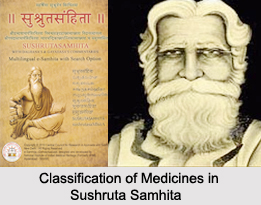 Sushruta divides remedial agents into two classes, namely, "Parthiva" or material and "Kalakrita" or affected by time, such as wind, sun-shine, shade, moon-light, darkness, heat, cold, rain, day, and night, changes of the moon, months and seasons of the year, etc. These are all said to affect the humours of the body, and, through them, the diseases caused by their derangement. The influence of these agents, if properly regulated or availed of, some times cures diseases, without the aid of material remedies.
Sushruta divides remedial agents into two classes, namely, "Parthiva" or material and "Kalakrita" or affected by time, such as wind, sun-shine, shade, moon-light, darkness, heat, cold, rain, day, and night, changes of the moon, months and seasons of the year, etc. These are all said to affect the humours of the body, and, through them, the diseases caused by their derangement. The influence of these agents, if properly regulated or availed of, some times cures diseases, without the aid of material remedies.
Sushruta divides medicines into 37 classes, named after the first article of each class. The medicines included in each class have certain common properties, such as acidity, sweetness, astringency, etc., are often used in combination, and can be substituted for one another. This has the advantage of bringing analogous substances under one head, but numerous medicines come to lie written under two or more heads. The "Nighantu" and some other works on the properties of medicines adopt the following classification in describing them:
1. Strongly scented substances
2. Moderately scented substances
3. Weak scented substances
4. Extracts
5. Precious stones
6. Metals
7. Sweet plants
8. Acid plants
9. Potherbs
 10. Bitter herbs
10. Bitter herbs
11. Flower plants
12. Fruit bearing creepers
13. Root-stocks
14. Large trees
15. Middle sized trees
16. Small trees or shrubs
17. Creepers
18. Corn and Pulses
19. Cooked food
20. Different sorts of water
21. Fluids as milk, honey, etc.
22. Necessaries of life, such as bathe, dress, ornaments, etc.
23. The influence of the elements and imponderables, etc.
This article is a stub. You can enrich by adding more information to it. Send your Write Up to content@indianetzone.com
Related Articles
Ayurveda
History of Ayurveda
Origin of Ayurveda
Ayurveda Medication
Elements of Ayurveda
Concepts of Ayurveda
Branches of Ayurveda
Ancient Literature of Ayurveda
Sushruta Samhita




















